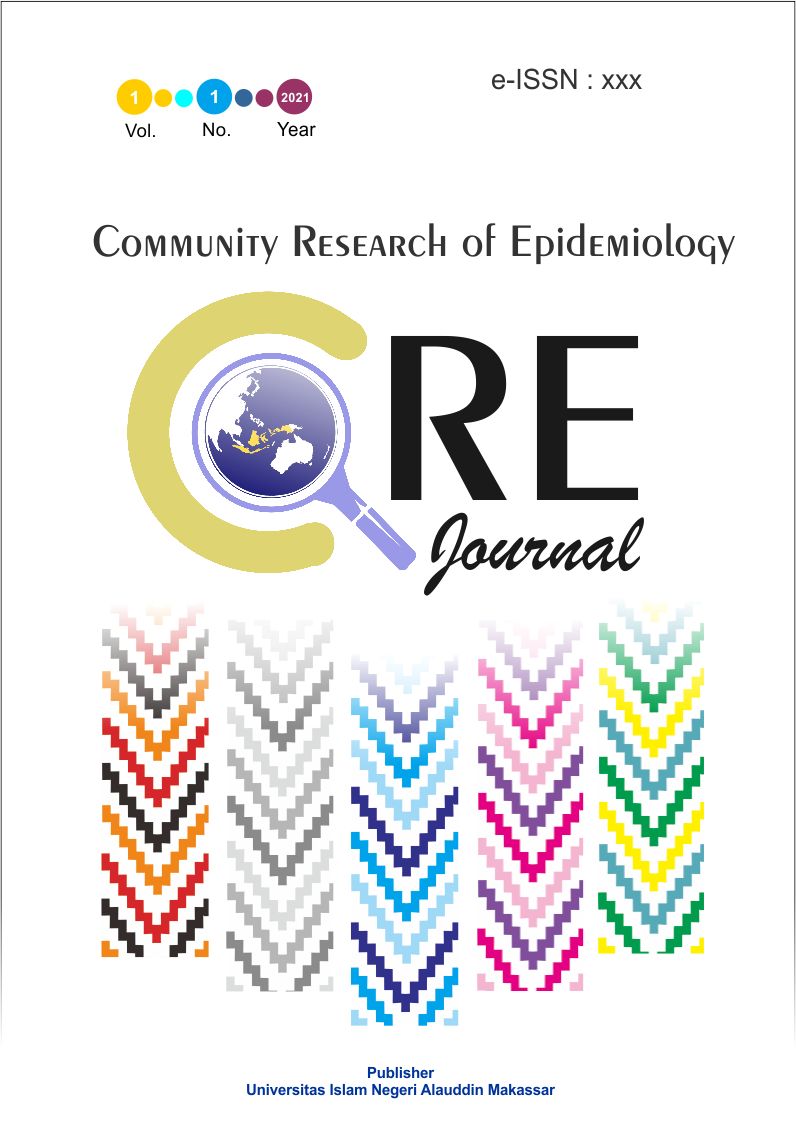The social factors of low birth weight in working area of sudiang health center makassar, 2019
Abstract
The cases of low birth weight are closely related to the problems of growth and development in infants. There are several factors that contribute to low birth weight. This study aimed to determine the social factors of low birth weight in working area of Sudiang Health Center, Biringkanaya, Makassar in 2019. This was observational study with case control design. The comparison of case and control was 1:1. About 28 cases were selected with purposive sampling technique. Data were analysed with chi square test and odds ratio calculation. The results showed that social demographic factors such as knowledge (OR=4.50), attitudes (OR=1.56), behaviours (OR=6.60), health status (OR=2.06), and family support (OR=2.81) influenced the low birth weight in infants. Activities pattern (OR=0.51) and cultures (OR=0.39) identified as protective determinants of low birth weight. The awareness of the society on the importance of health and the risk of low birth weight was needed to be increased by education given by the health officers by using a number of different methods.References
Audrey, H. M., & Candra, A. (2016). Hubungan Antara Status Anemia Ibu Hamil Trimester Iii Dengan Kejadian Bayi Berat Lahir Rendah Di Wilayah Kerja Puskesmas Halmahera, Semarang. Jurnal Kedokteran Diponegoro, 5(4), 966–971.
Budiarni, W., & Subagio, H. W. (2012). Hubungan Pengetahuan, Sikap, Dan Motivasi Dengan Kepatuhan Konsumsi Tablet Besi Folat Pada Ibu Hamil. 1(1), 99–106. https://doi.org/10.14710/jnc.v1i1.364
Dinas Kesehatan Prov. Sulsel. (2018). Situasi Kelahiran di Wilayah Provinsi Sulawesi Selatan 2017-2018.
Dinkes Kota Makassar. (2017). Persentase BBLR Tahun 2015-2017.
Fatimah, N., Utama, B. I., & Sastri, S. (2018). Hubungan Antenatal Care dengan Kejadian Bayi Berat Lahir Rendah pada Ibu Aterm di RSUP Dr. M. Djamil Padang. Jurnal Kesehatan Andalas, 6(3), 615. https://doi.org/10.25077/jka.v6.i3.p615-620.2017
Kementerian Kesehatan RI. (2013). Pokok-Pokok hasil Riskesdas Indonesia 2013. Badan Penelitian Dan Pengembangan Kesehatan, iii. https://doi.org/10.1017/CBO9781107415324.004
Kurniasari, L. (2016). Hubungan Motivasi Dan Dukungan Keluarga Ibu Hamil Dengan Pencegahan Risiko Tinggi Kehamilan Di Puskesmas Rawasari Tahun 2016. 5(02), 193–199.
Notoatmodjo, S. (2005). Promosi Kesehatan, Teori dan Aplikasi. Rineka Cipta.
Notoatmodjo, S. (2010). Ilmu Perilaku Kesehatan. Rineka Cipta.
Purwati, H., & Maharani, K. (2013). Faktor-Faktor Yang Mempengaruhi Kejadian Bblr (Bayi Berat Lahir Rendah) Di Rsu Dr. Wahidin Sudiro Husodo Mojokerto.
Rahayu, D. (2016). Gambaran Kejadian Bayi Berat Lahir Rendah (Bblr) Di Rsud Kota Kendari Provinsi Sulawesi Tenggara Tahun 2015.
Rofiah, siti zakiyatur, Husain, F., & Arsi, A. A. (2019). Knowledge and Decision Making in Food Consumption of Pregnant Women (Case study on Pucakwangi Subdistrict Pati Regency). 6(2), 1–13.
Senewe, F. P. (2012). Status Kesehatan Masyarakat Di Daerah Tertinggal Community Health Status In Less Development Areas.
Sistiarani, C. (2008). Faktor Maternal dan Kualitas Pelayanan Antenatal yang Berisiko terhadap Kejadian Berat Badan Lahir Rendah (BBLR). 1–86.
Sivanganam, S., & Weta, W. (2017). Gambaran tingkat kepatuhan ibu hamil mengkonsumsi tablet besi di wilayah kerja puskesmas Sidemen tahun 2015. 8(2), 135–138. https://doi.org/10.1556/ism.v8i2.128
Siany, L., & Atiek, C. B. (2009). Khasanah Antropologi 1. Pusat Perbukuan Departemen Pendidikan Nasional. http://bse.depdiknas.go.id
Sugesti, R. (2015). Gambaran psikologis ibu jelang melahirkan dan pasca melahirkan.
Shihab, M. Q. (2002). Tafsir Al Misbah: Pesan, Kesan dan Keserasian Al-Qur’an (Volume 12). Lentera Hati.
WHO. (2014). Global Nutrition Targets 2025: policy brief series (WHO/NMH/NHD/14.2). World Health Organization.
Septiani, R. (2015). Faktor Maternal Pada Kejadian Berat Badan Lahir Rendah (BBLR) di Indonesia (Analisis Data Riskesdas 2013).
Yolanda, G., Siswosudarmo, R. ., & Ganap, E. P. (2016). Hubungan Antara Anemia Ibu Hamil Dengan Kejadian Berat Badan Lahir Rendah Pada Kehamilan Cukup Bulan Di Rsup Dr Sardjito Yogyakarta.


